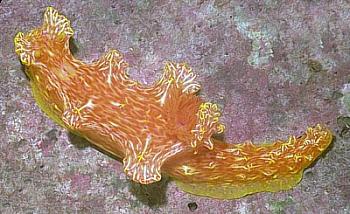

Ceratosoma moloch
Rudman, 1988
Order: NUDIBRANCHIA
Suborder: DORIDINA
Superfamily: EUDORIDOIDEA
Family: Chromodorididae
DISTRIBUTION
Western Pacific
PHOTO
NW of Point Lookout, Nth Stradbroke Is, sthn Queensland, Australia, 11m, 29 July 1985, Paratype AM C147845. 112mm long alive. PHOTOS: R.C.Willan.
Two specimens from Heron Island had a pink background colour with whitish pink tubercles and tuberculate regions outlined with an irregular band of cream. There is an irregular whitish border along the edge of the foot. The rhinophores are a translucent pink with some white specks but no white tip to the club. The gills are translucent pink.
A smaller specimen from North Stradbroke Island is translucent pink with mottled reddish pink all over. On the dorsum there are whitish longitudinal streaks which on the lateral mantle lobes become transverse and radial lines. These lines are bright white changing to yellow near the edge. Each tubercle, both on the lateral lobes and elsewhere on the body, has a series of white or yellow lines running up to the tip. Scattered over the lobes, and on the larger tubercles on the foot are diffuse purple spots. These are also found around the edge of the foot which is tinged with yellow.
The rhinophores are a yellowish orange with some white specks on the club. The gills are translucent orange with a thin reddish line along the rachis.
The mantle skirt has been reduced to three flattened tuberculate lobes on each side of the body. There are a pair on either side of the head and a large pair just in front of the gills. The third pair are midway between the head and gill lobes. In the midline, just behind the gills the posterior end of the mantle is produced into a large recurved horn. In the larger specimen the middle and posterior pair of lobes and the posterior horn have become rounded and multituberculate. Between the lobes the mantle edge is either reduced to a slight ridge or absent. There are a few small conical tubercles on the mantle and some beneath on the sides of the body. Behind the mantle however the posterior foot is heavily tuberculate with many of the more dorsal tubercles being compound.
Reference:
• Rudman, W.B. (1988) The Chromodorididae (Opisthobranchia: Mollusca) of the Indo-West Pacific: the genus Ceratosoma J.E. Gray. Zoological Journal of the Linnean Society, 93(2): 133-185.
Rudman, W.B., 2000 (December 29) Ceratosoma moloch Rudman, 1988. [In] Sea Slug Forum. Australian Museum, Sydney. Available from http://www.seaslugforum.net/factsheet/ceramolo
Related messages
-
Colour variation in Ceratosoma moloch
From: David Mullins, June 2, 2008 -
Ceratosoma moloch found sthrn Queensland
From: Gary Cobb, December 13, 2007 -
Re: Ceratosoma moloch from southern Queensland, Australia [2]
From: Bruce Wilkie, September 1, 2006 -
Re: Ceratosoma moloch from southern Queensland, Australia [1]
From: Bruce Wilkie, September 1, 2006 -
Ceratosoma moloch from southern Queensland, Australia
From: Bruce Wilkie, February 20, 2006 -
Ceratosoma moloch from Okinawa
From: Bob Bolland, August 23, 2001 -
Ceratosoma moloch from the Solomon Ids
From: Scott Johnson, January 2, 2001
